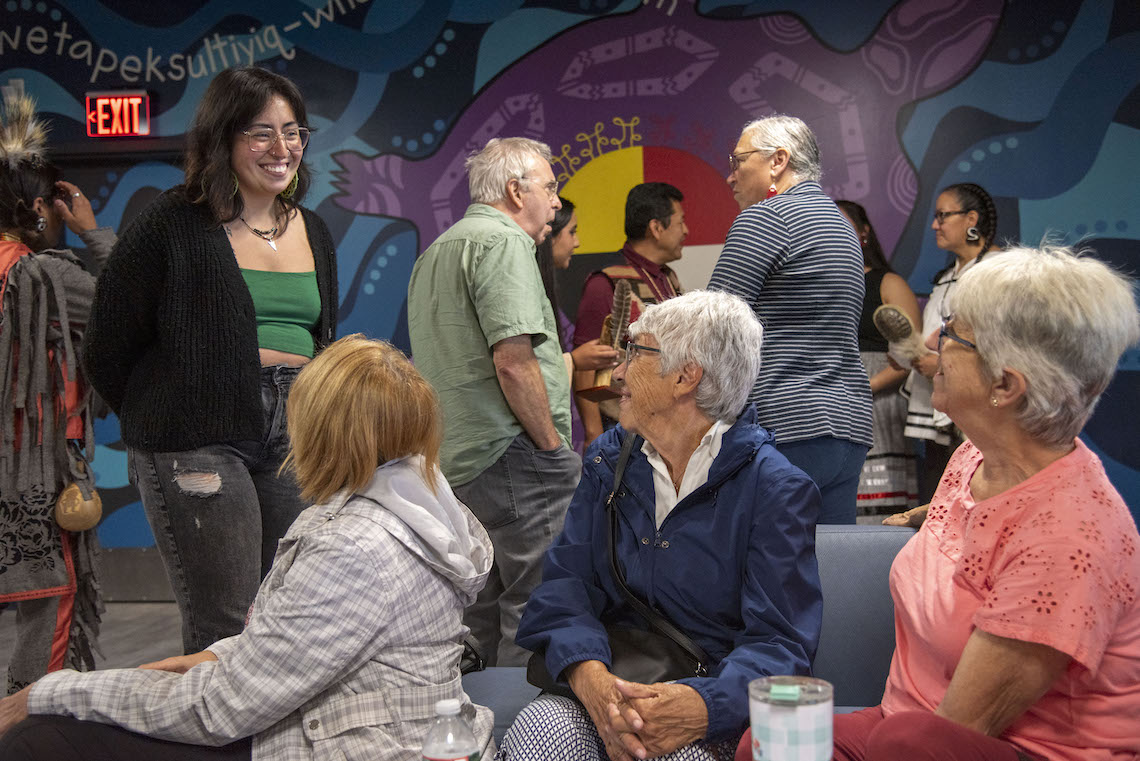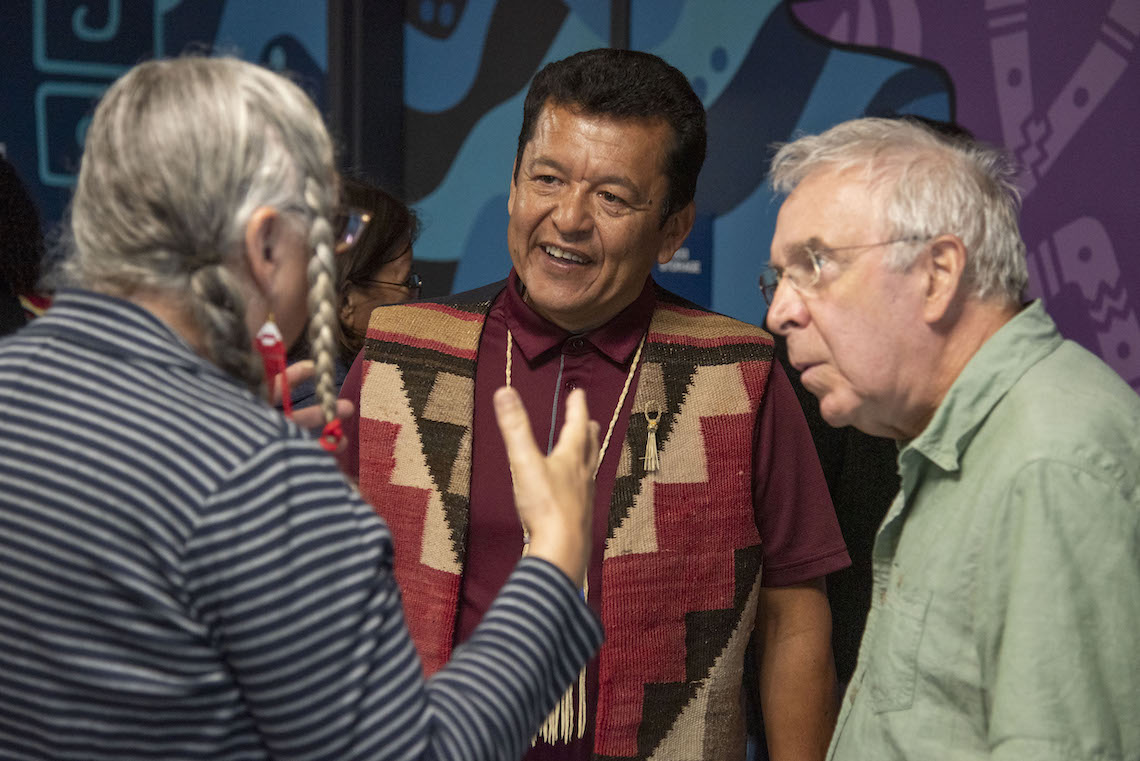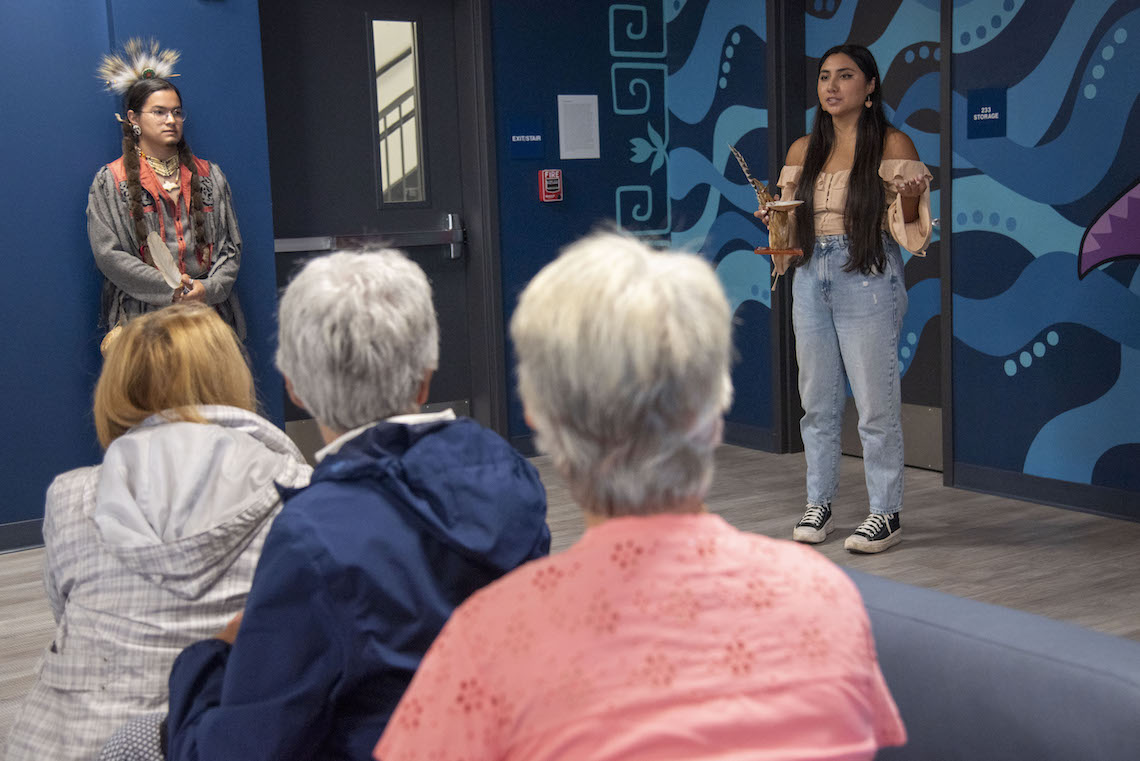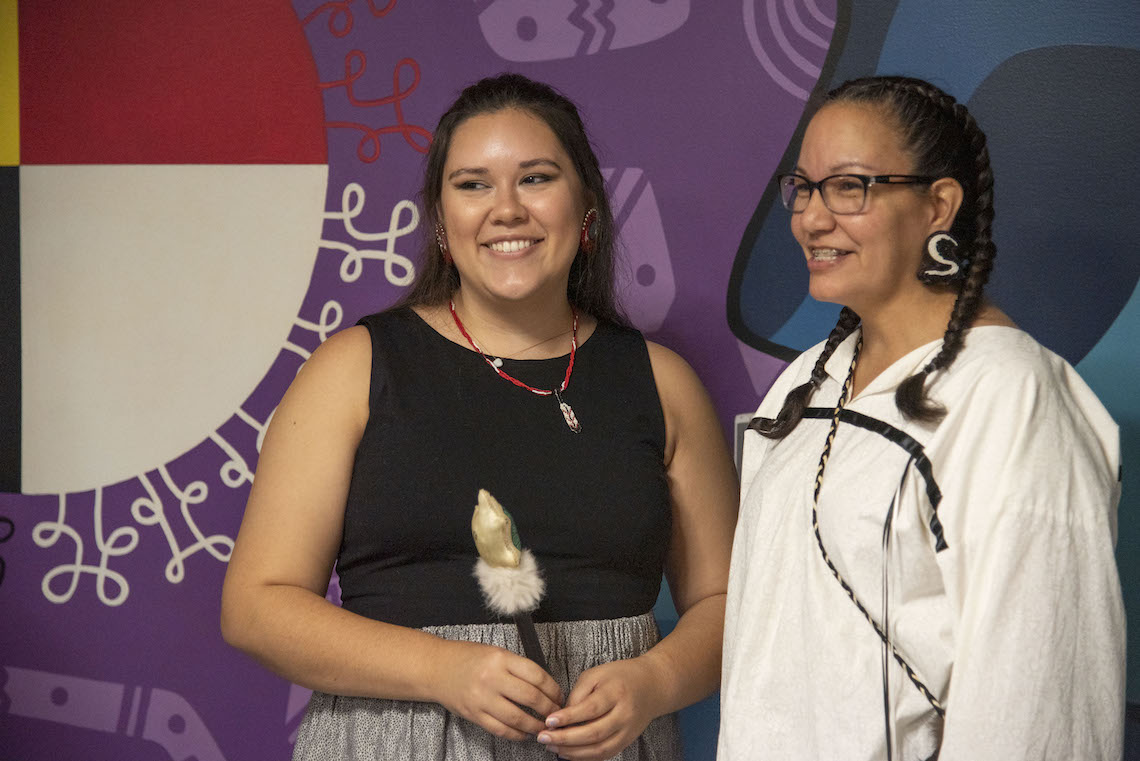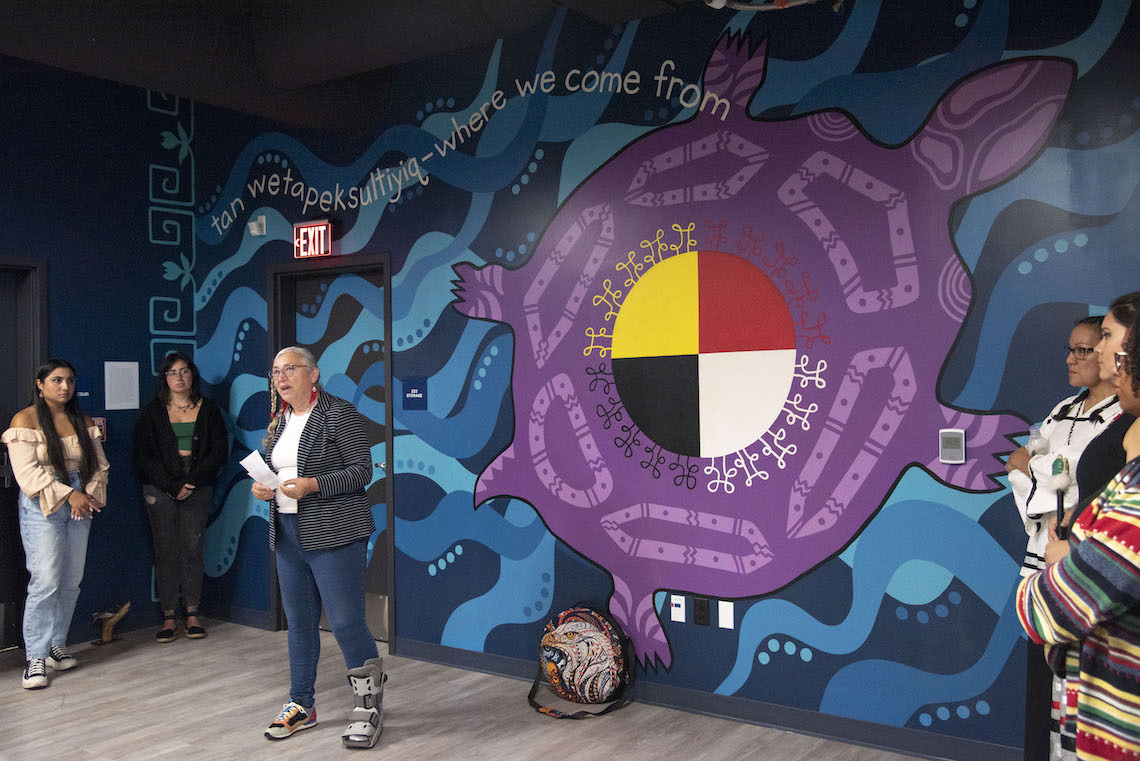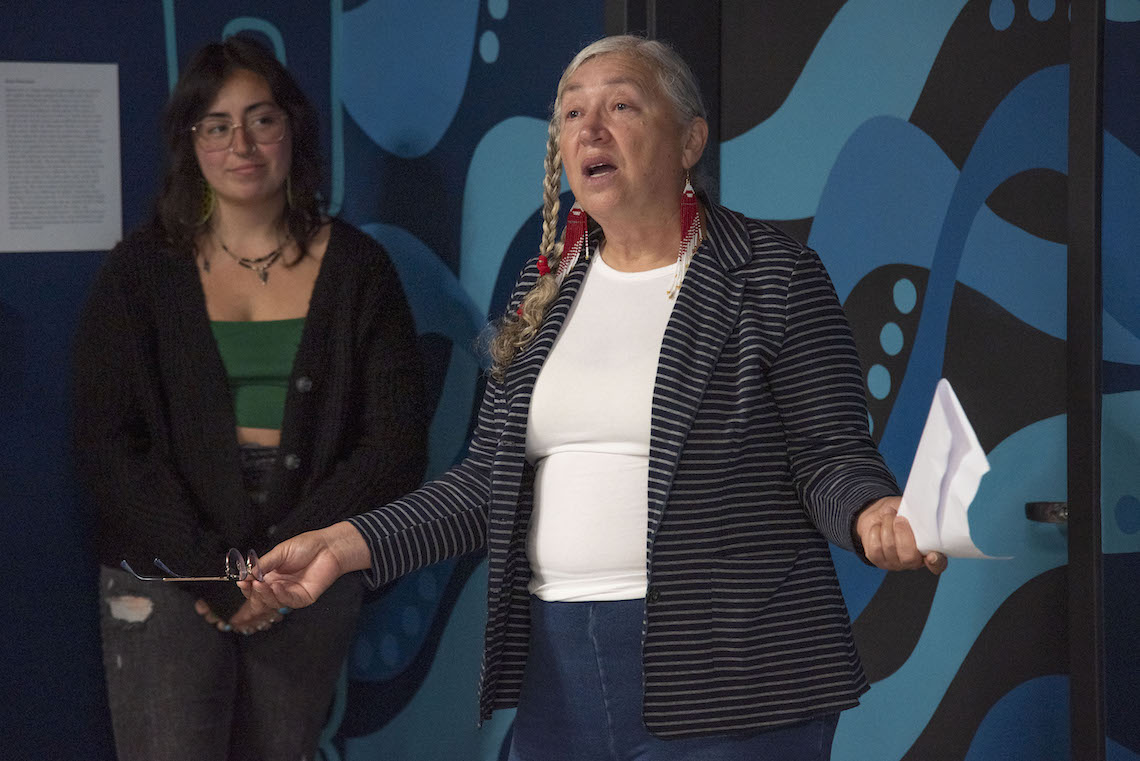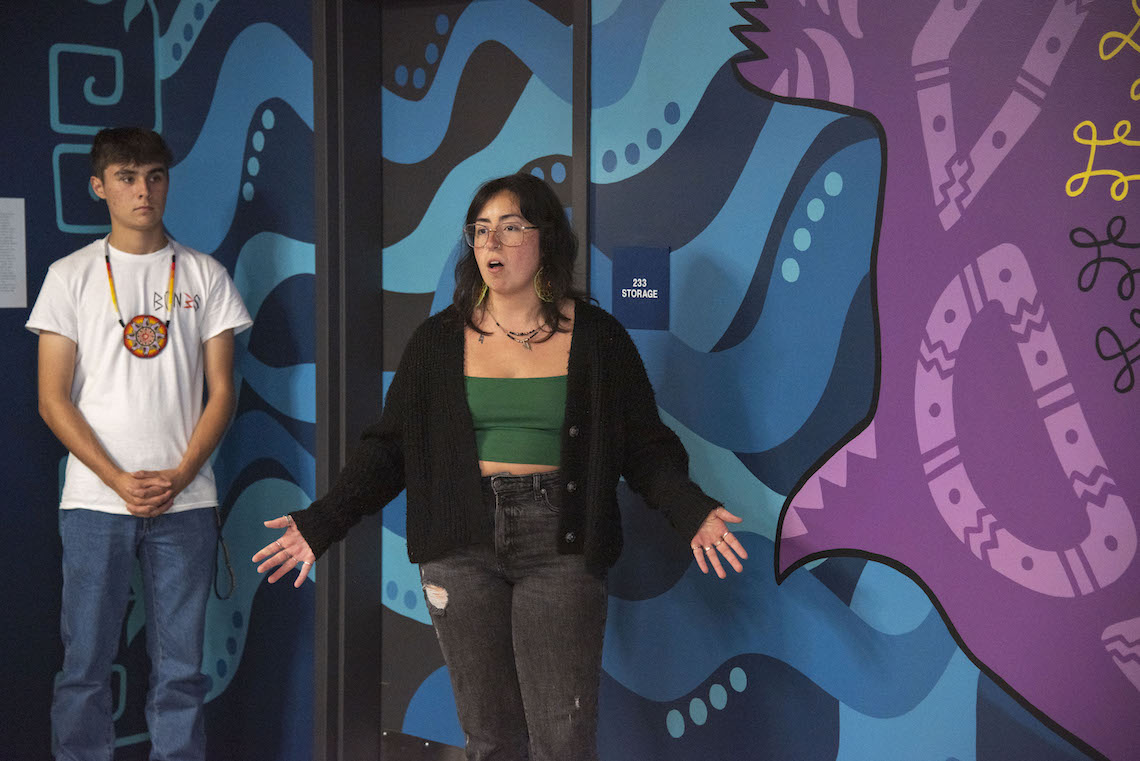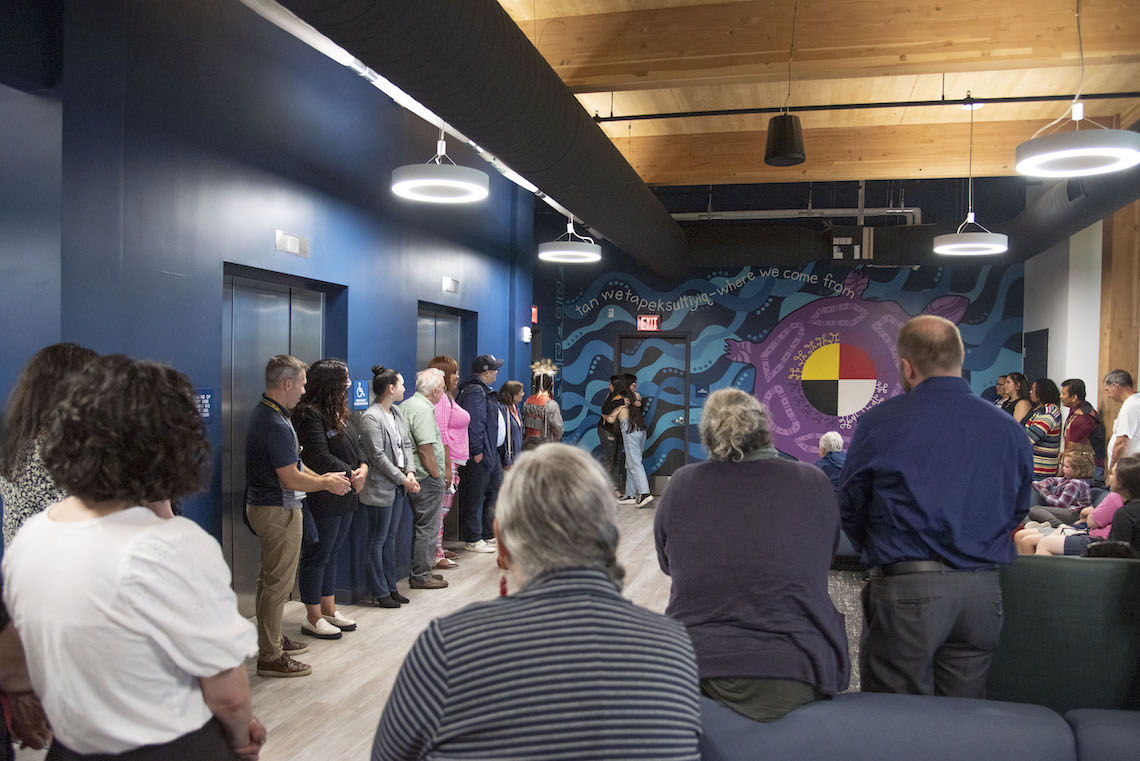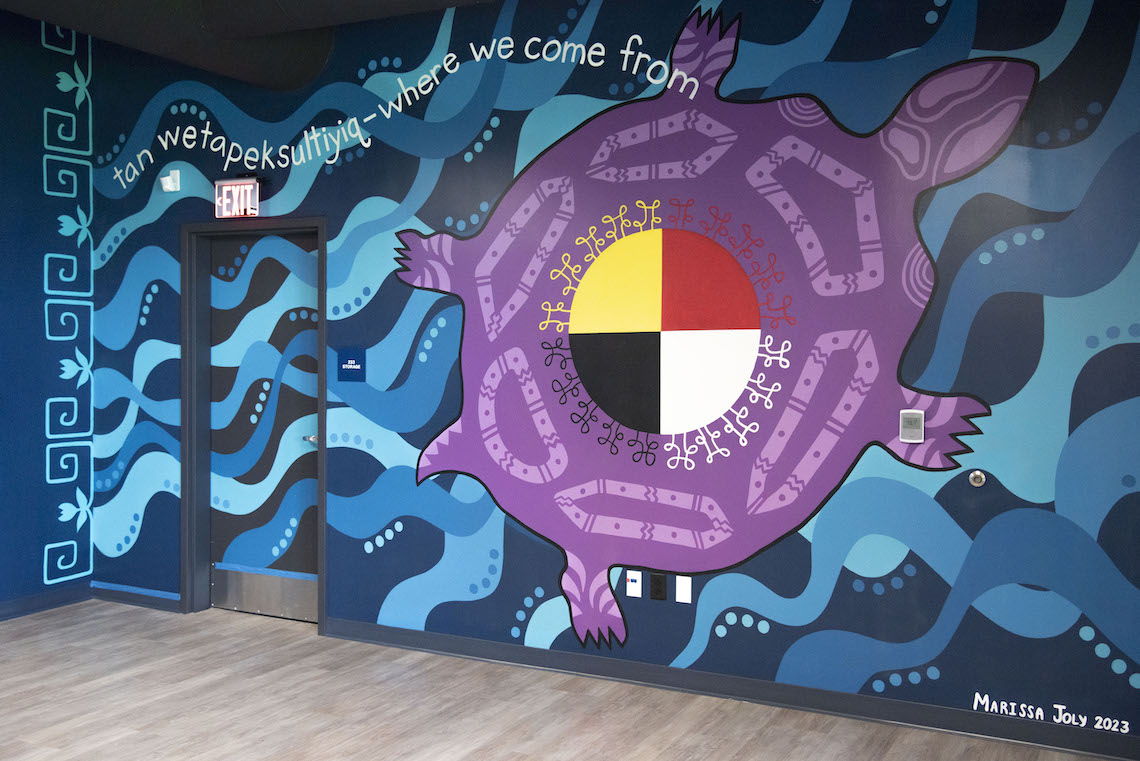
With a paintbrush and her imagination, Marissa Joly is fulfilling a dream from her college days by creating an enclave for Native American culture at the University of Southern Maine.
Joly worked through the summer to paint a mural on a second-floor wall in the McGoldrick Center for Career and Student Success. After years of construction, the new building will be fully operational to begin the 2023 fall semester. Joly is proud that her vision will occupy a prominent place at the heart of the Portland Campus.
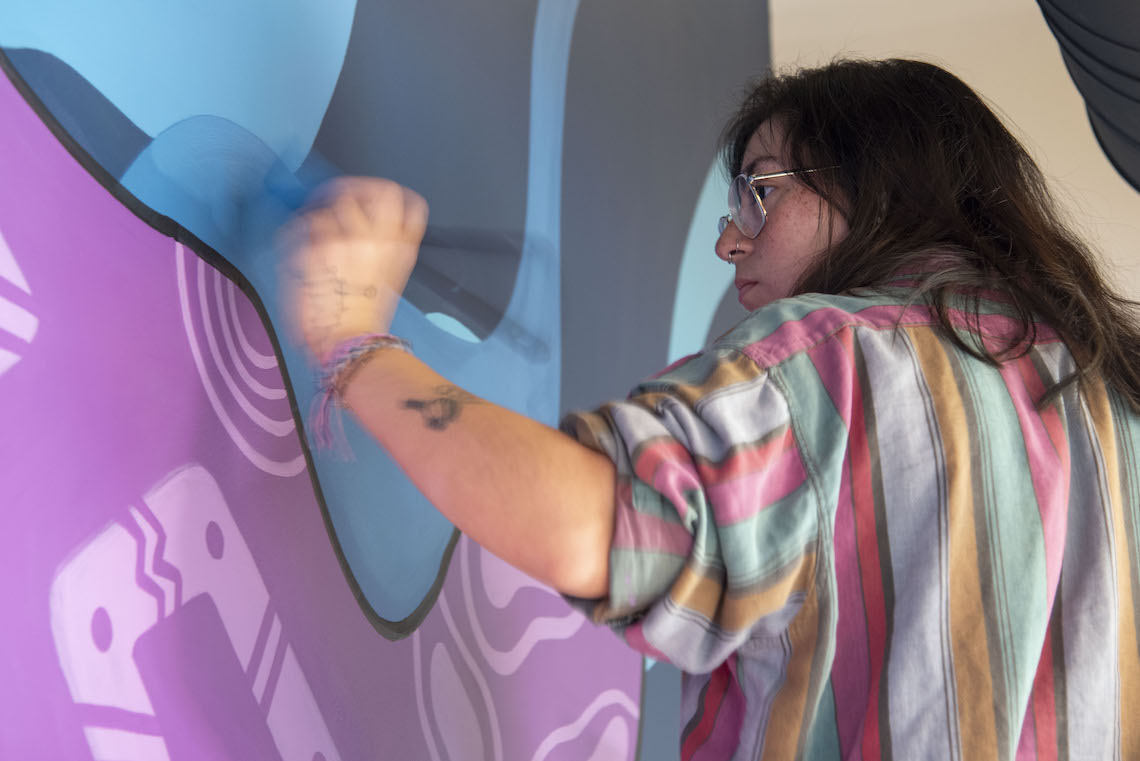
“I hope that Native American students particularly will feel seen and heard and have a space that they can feel connected to,” Joly said. “This can be a safe space for them, where they can feel okay to be accepted or to delve further into their culture if they haven’t before.”
With her first layer of paint, Joly transformed the bare drywall into a seascape of swirling blue streaks. Swimming across the surface is a purple turtle representing all of North America as told in Native American creation stories. At the center of its shell is a medicine wheel, a symbol of natural balance considered sacred to many Indigenous people.
Joly saved space in the upper right corner for the mural’s title, “tan wetapeksultiyiq – where we come from.” The first half of the inscription is written in the Passamaquoddy language. The Mi’kmaq language is also represented in the curving hieroglyphs that run along the mural’s edges. Loosely translated, they can be read as a “Native person” or “land dweller.”
The Passamaquoddy and Mi’Kmaq peoples are part of the Wabanaki Confederacy, which also includes the Maliseet and Penobscot nations. Together, they once held dominion over the territory now known as Maine, prior to the arrival of European settlers.
Joly’s Mi’kmaq heritage informs and inspires her art. It also motivated her to take an active role in the campus community as a student. Joly graduated from USM in 2021 with a degree in Studio Art. While getting her education, she also educated those around her through her extracurricular work with the Native American Student Alliance.
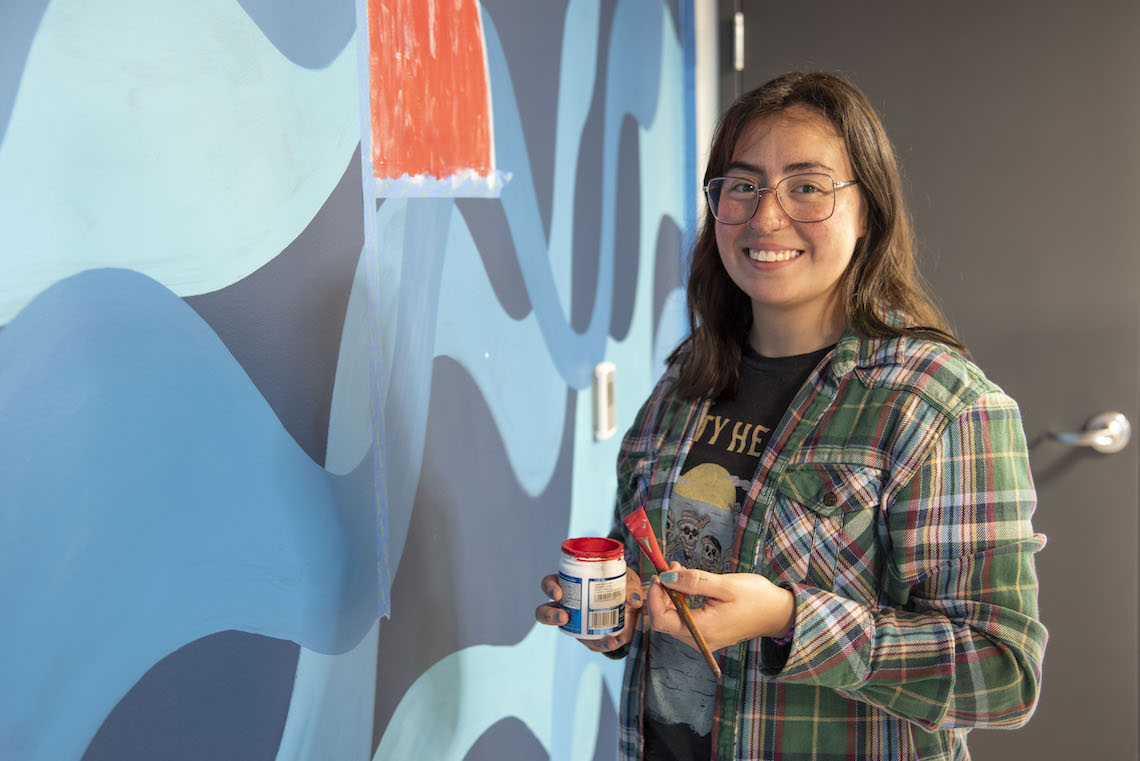
Joly and likeminded classmates revived the long-dormant group and their advocacy got results. The Linguistics Department responded to their calls for greater academic representation by launching a Wabanaki languages certificate program. The Alliance also worked with University leaders on a statement to be read at public events acknowledging the campus’ Native history.
“I’ve dealt with having an identity crisis where I felt like I wasn’t Native American enough to be Native, to follow the culture,” Joly said. “Even though I’ve always felt a connection to it, there was always that struggle of ‘What’s my blood percentage? Am I enough percentage to be Native?’ I feel like there’s probably a lot of people who feel that way.”
Joly has relatives who live on the Listuguj reservation in southeastern Quebec. She doesn’t see them as much as she’d like because of the distance from her home in the central Maine town of Durham. Just as she had in college, Joly continued to honor their shared heritage in her career.
The Portland School District commissioned Joly to paint murals at two schools. She used different arrangements of the now-familiar ocean, turtle, and Mi’kmaq hieroglyph motifs. Her confidence and skill grew with each project.
When USM launched its own mural project last year, Joly jumped at the chance. But first, she had to convince the selection committee that she was the right artist for the job. The mural had to fit a wall measuring just over nine feet high and 19 feet wide. It would serve as the backdrop for an informational kiosk with literature and video offerings about Wabanaki history.
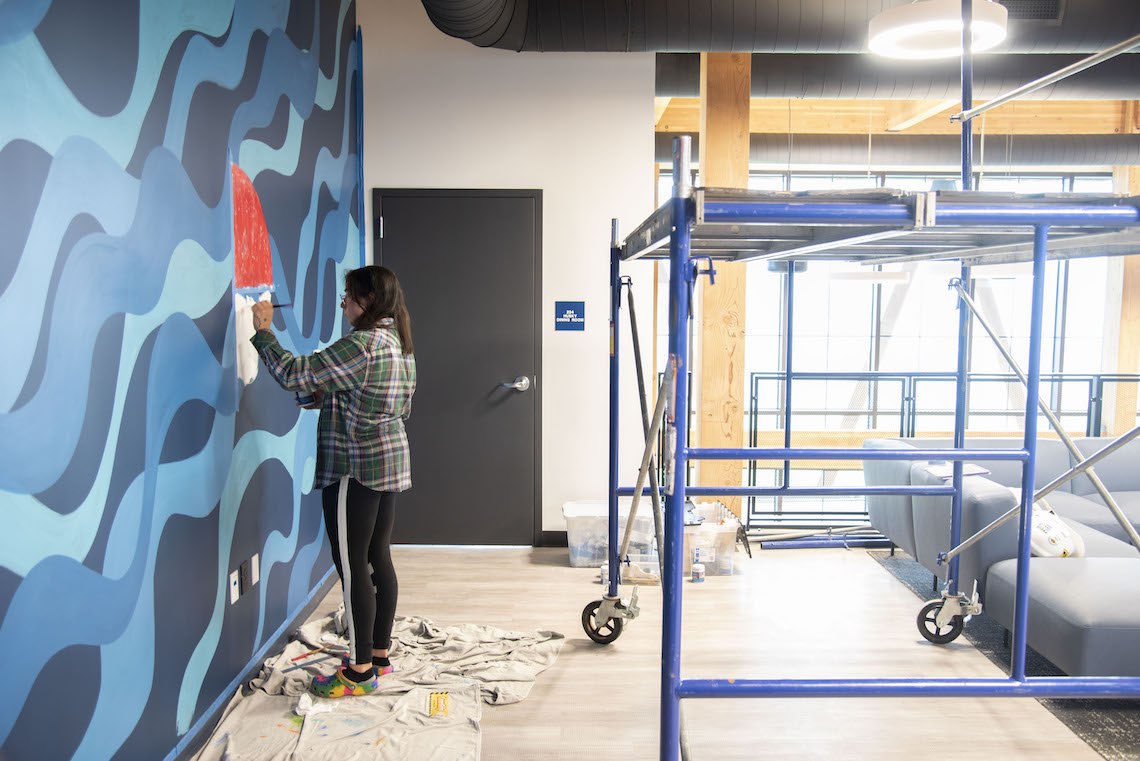
Chris Brown was one of two students who helped University leaders choose between the applicants. He was then a sophomore, majoring in Philosophy. Brown is also a member of the same campus group that Joly helped revive, which has since changed its name to the Student Alliance of Indigenous Peoples. His family has roots in the Lipan Apache tribe from Texas.
“I feel like Marissa’s piece really hits home in saying that we’re all one people. It does have some Wabanaki characteristics in it like the double curve, which is fantastic, and I think it’s important to recognize the land that we are on which is Wabanaki territory,” Brown said. “At the same time, I think Marissa’s piece does echo the fact that we’re all one people.”
The unifying message and the beauty of Joly’s composition ultimately won over the committee. She began painting in mid-June. For the next few weeks, she navigated every challenge that stood in the way of her vision.
Joly painted around electrical outlets and doorways. She adjusted to the lighting from a nearby bank of windows that rose two stories high across the entire front of the building. Depending on the weather and time of day, the mural could be bathed in sunlight or shadow. And Joly had to maintain focus in the middle of an active construction site.
The spirituality of Joly’s art compliments the functionality of the new construction. The McGoldrick Center is more than a collection of office space. Students share meals in the dining hall on the first floor. And a short corridor connects the building to the new dorms in the Portland Commons complex.
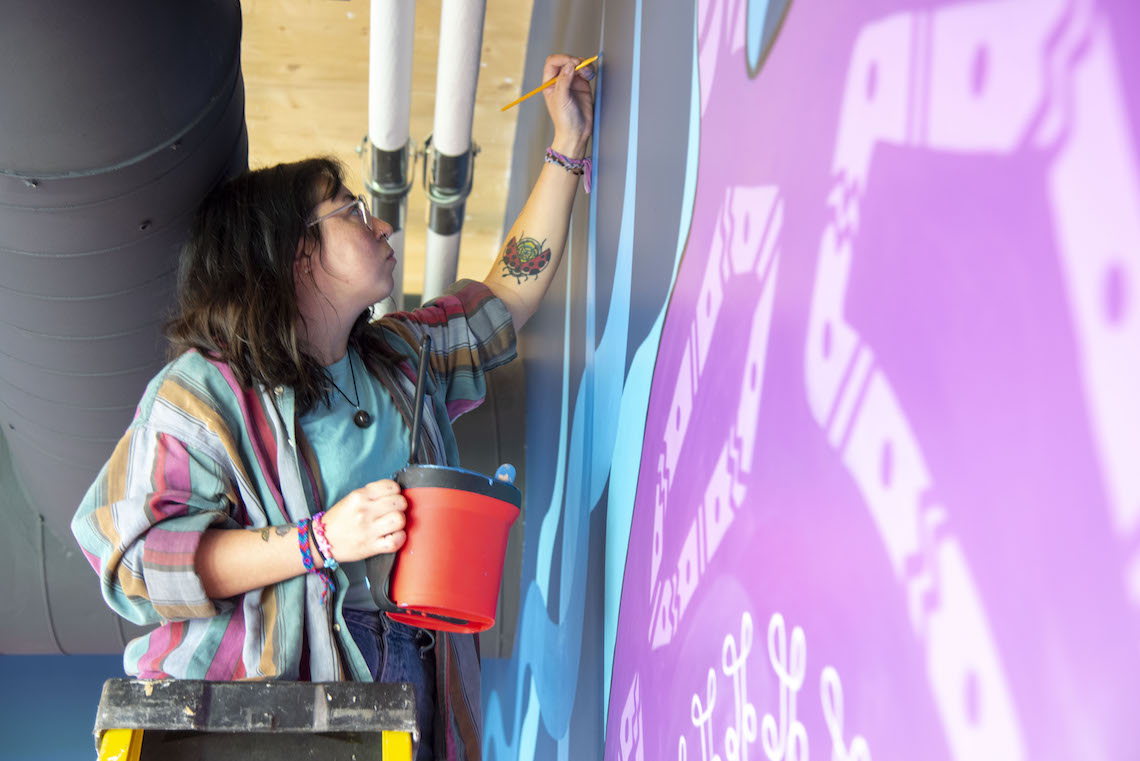
Kat Zagaria Buckley believes art is essential to any place where students spend so much of their personal time. As Director of Art Exhibitions and Outreach, Buckley also served on the selection committee for the mural. Its symbolism impressed her from the start, and she looks forward to seeing how its message resonates with students.
“It’s really important for students to feel like the space that they have is their own and that it reflects their tastes and their values,” Buckley said. “Art in domestic spaces really can be indicative of what someone is interested in, what they value, who they are friends with.”
Joly finished the painting by August 15. She returned a short time later to apply a protective coating. By then, preparations for the fall semester were just getting started with the arrival of resident assistants and orientation leaders. The full student body would soon follow. Not so long ago, Joly had been one of them.
“It feels great to be a part of this and especially at my alma mater,” Joly said. “It’s really cool to have that opportunity to put my mark on where I went to school, and where I learned a lot, and carry that forward.”
After weeks of working alone, Joly suddenly found herself at the center of a grateful crowd at the mural’s official unveiling on September 12. The halls of the McGoldrick Center were filled with traditional songs and drumming, along with a whiff of smoke from the herbs that were burnt in a smudging ceremony.
It was the kind of celebration Joly had always wanted for the University’s Indigenous community. And it happened in front of the mural she created.
